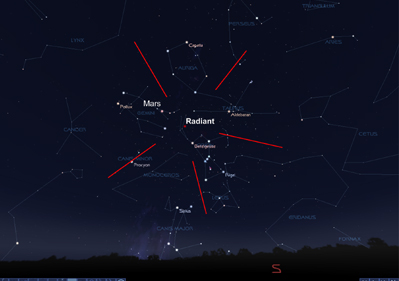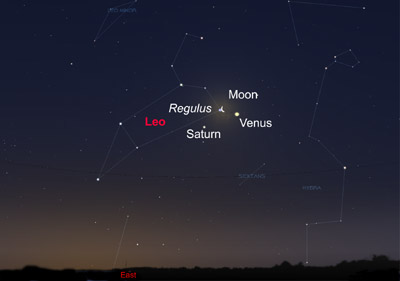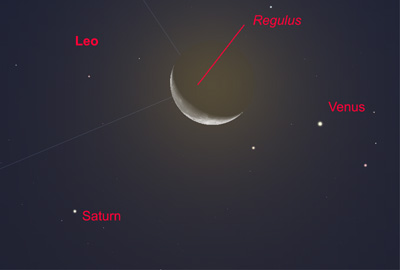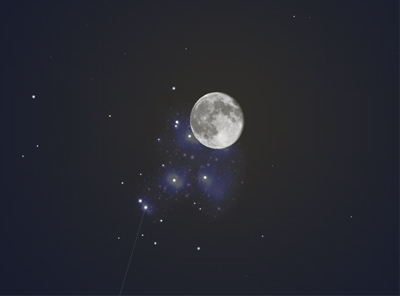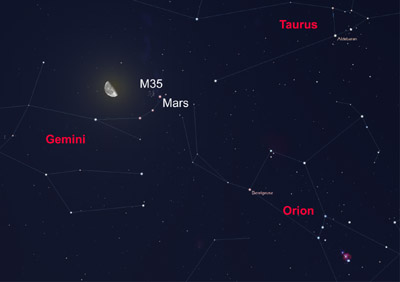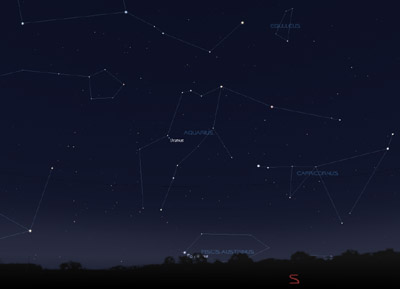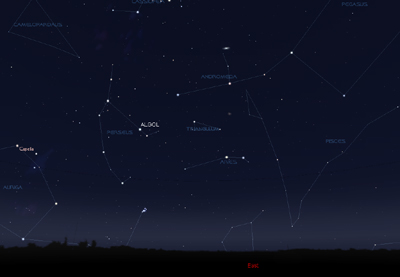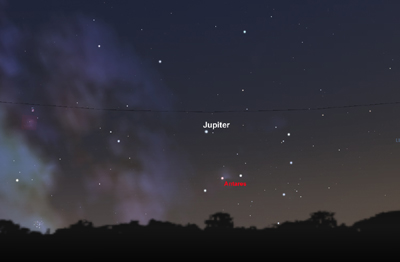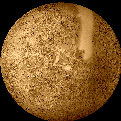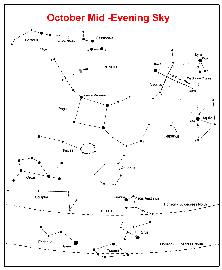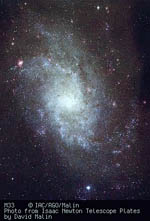The Night Sky October 2007
Compiled by Ian Morison
This page, updated monthly, will let you know some of the things that you can look out for in the night sky. It lists the phases of the Moon, where you will see the naked-eye planets and describes some of the prominent constellations in the night sky during the month.
Image of the Month
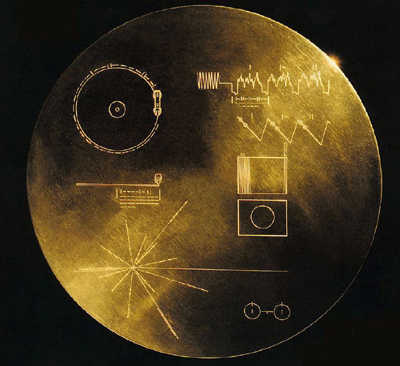
The Voyager record - click for full sized image
Image: Voyager Project, JPL, NASA
Launched 30 years ago this autumn, the Voyager 1 spacecraft is now the most distant man-made object in the Universe and, on August 17th this year, crossed the 100 AU "boundary" as it heads into interstellar space. It now lies at a distance of 15 billion km (9.3 billion years). Voyager 1, with its twin Voyager 2 (now 80 AU distant), carry what is called the Voyager Record - an early form of a CD rom, but on a disc - whose golden cover is shown above. Its contents were put together by a committee under the chairmanship of Carl Sagan whose wife had drawn the plaque carried by the earlier Pioneer spacecraft. In his book "Murmurs of Earth", he describes how the committee chose the contents. Frank Drake (of SETI fame) suggested that there be pictures on one side and speech and music on the other. 115 images were assembled along with a variety of sounds such as those made by surf, wind and thunder, birds, whales and other animals. To these were added musical selections from different cultures and spoken greeting in fifty-five languages. These begin with the Akkadian language spoken in Sumer about 6,000 years ago and end with Wu, a modern Chinese dialect.
The record is encased in an aluminium jacket with a cartridge and needle. the cover, shown above, contains information about how to play the record, but also some interesting material. At the bottom right is a diagram of the Hydrogen atom and its two "hyperfine states" which correspond to an energy difference that would emit a photon of wavelength 21 cm. This defines a standard of length - 21cm but also of time: 1/f where f is the frequency of the photon ~1,400 MHz. At the lower left is a "map" of the plane of the galaxy which shows the Sun's position in relation to 12 pulsars whose periods are given in binary code. As Pulsars slow with time at varying rates, there is only one time in the life of the Universe when these pulsars would have these periods, so an alien race could not only find out where we were in the galaxy, but also when the spacecraft were launched!
The Moon

The passage of the Moon through the Earth's shadow March 2007: Cape Newwise 200 mm telescope and Nikon D80 camera.
Ian Morison, Jodrell Bank Observatory
| new | first quarter | full moon | last quarter |
|---|---|---|---|
| Oct 11th | Oct 19th | Oct 26th | Oct 03rd |
Highlights of the Month
Around October 21st: the Orionid Meteor Shower
Though the Orionids are not one of the most spectaculer showers with peak rates around 20 per hour, they are interesting as it is believed that the meteors originate from Comet Halley. It is worth looking out for them for a week around the 21st as the shower is long lived. They will best be seen in the hours before dawn when Orion is high in the southern sky. The star chart shows where they appear to radiate from - called the radiant - at the upper left of Orion, close to the boarder with Gemini. You will see Mars close by! Its best to look almost vertically where the sky is most transparent. The Moon, just past first quarter, will have set somewhat earlier so this should not hinder your view. The Halley meteors are amongst the fastest and enter the upper atmosphere at ~41 km per hour and often leave what are called persistant trains - streaks of ionized gas as the incoming dustparticles burn up in the atmosphere. Halley's Comet actually gives us two meteor showers per year as we intersect its orbit twice as the Earth orbits the Sun. The other is in May and the shower is called the Eta Aquarid shower.
October 7th before dawn: Venus, Saturn and the waning crescent Moon
Perhaps the best skyscape this month will be seen, if clear, in the east before dawn on the 7th of October. Venus will be shining brightly to the right of the thin crescent Moon with Saturn below and to its left. Whilst, in very close proximity to the Moon, and occulted during part of the night, will be the star, Regulus, in Leo. Depending on your location, you may see an occultation of Regulus from ~ 05:19 until ~ 06:00.
October 27th The Moon Occults the Pleiades Cluster
From ~10:UT on the 27th October through to ~ 01:00 on the 28th, the Moon - one day after full Moon - will pass across part of the Pleiades Cluster. Certainly worth a look if its clear!
October 3rd around 1 am: Mars, M35 and the waning Moon
Another beautiful grouping: In the early hours of October 3rd, the Moon, just after third quarter, will lie close to the planet Mars and the cluster M35 - all in the constellation Gemini. This should be a very nice grouping to observe with either binoculars or a low power telescope.
Seek out Uranus with binoculars or a telescope
October is another good month to observe the planet Uranus - perhaps for the first time - with binoculars, a small telescope or even your unaided eye! &nb &nbs On October 11th, the night of new moon, Uranus, with a magnitude of 5.8, lies just over 3 degrees up and to the left of the 4th magnitude star Lambda Aquarii. (If Lamdbda Aquarii is the centre of a clock, Uranus is at 10:00) During the month it drifts slowly westwards. Binoculars will easily show it and a small telescope will show a blue-green disc just under 4 arc seconds in angular diameter. Around the time of new moon (~11th October) under dark and transparent skies you even be able to see it with your unaided eyes. Have a go!
Find the Andromeda Galaxy and observe Algol wink!
The autumn is a good time to find the Andromeda galaxy. It is near the top of the chart just to the right of centre. Start at the top left star (Alpheratz) of the square of Pegasus, move round two bright stars to the left and up a bit to reach Mirach. At this point turn sharp right, move up one star and then the same distance again. A fainter star is passed and then you should see a fuzzy glow - that is the Nucleus of the Andromeda Galaxy. 10x50 binoculars on a really dark transparent night will show the disk extending out from the nucleus.
To the left of the tiny constellation Triangulum is the Star Algol in Perseus.
It is an eclipsing binary and every 2.87 days its brightness drops by more than a magnitude and then rises again. In October you can watch this happen over a period of hours around 22:50 UT on the 21st and 19:38 UT on the 24th.
The Planets
Jupiter
Jupiter may just be seen in the south-west as the Sun sets as the month begins, and this is really the last week or so to observe it for a while. At the beginning of the month it is just 20 degrees above the horizon an hour after sunset so is seen in the twilight - by months end this will have dropped to 12 degrees. It shines with a magnitude of -1.9 and its disk is now down to 34 arc seconds. To be totally honest, its probably not worth observing until it appears in the pre-dawn sky in a few months time.
A small telescope (or even binoculars resting on a wall to steady them) will allow you to observe the 4 bright Galilean Moons, Io, Europa, Ganymede and Callisto, discovered by Galilo Galilei in 1610.
Saturn
Saturn As October begins, Saturn, 3.6 degrees down to the lower left of the star Regulus in Leo, is seen in the pre-dawn sky. They gradually move apart and by the end of the month Saturn is ~6 degrees to the lower left of Regulus. At magnitude +0.7 (rising during the month to +0.8) Saturn will not be as bright this coming year as it sometimes is: the rings are closing (just ~ 8 degrees tilt to us and subtending only 5 arc seconds) and thus there is less apparent reflecting area. A small telescope will easily show its moon, Titan, and show some bands around the surface. As Saturn gradually rises earlier than the Sun and can be seen higher in the sky, it will be easier to make out its surface features. See also the highlight above.
Mercury
Mercury At the very beginning of October, Mercury might just be visible in evening sky about 20 to 30 minutes after sunset. It is very low above the horizon and will not be easy to spot. To have a chance, get to a location with a very low western horizon and observe where the Sun sets. With binoculars you may then be able to spot Mercury, at magnitude at -0.1 just above the horizon to the left of where the Sun has set. (In the south-west) Mercury passes between the Earth and the Sun on October 23rd at what is called "inferior conjunction" before it becomes visible in the pre-dawn sky.
Note that the blank region in the image above is simply because this part of Mercury's surface has not yet been imaged in detail.
Mars
Mars, is in Gemini during October and is now rising around 10 pm and reaches an elevation of about 60 degrees in the south by 5 am. Its disk is just 9.7 arc seconds across and it shines at magnitude -0.1 at the beginning of October. During the month its brightness increases to magnitude -0.6 and it angular size increases to 12 arc seconds so features will be easily seen on the surface if the "seeing" is good. We still need to wait a month or so before we see it really well, but under good conditions the polar caps and Sytis Major (a prominent dark marking on the surface) should be visible in a small telescope during the evening at the beginning of October. Mars will reach opposition in December - a highlight of the winter months. See also the highlight above.
Venus
Venus is now shining brightly dominating the eastern pre-dawn sky! It was at is very brightest in late September but still shines at magnitude -4.7 - the brightest object in the sky apart from the Moon! Viewing it with a telescope will reveal a 38% illuminated crescent. See also the highlight above.
Find more planetary images and details about the Solar System: The Solar System
The Stars
The Evening October Sky
This map shows the constellations seen towards the south in mid evening. To the south in early evening - moving over to the west as the night progresses is the beautiful region of the Milky Way containing both Cygnus and Lyra. Below is Aquilla. The three bright stars Deneb (in Cygnus), Vega (in Lyra) and Altair (in Aquila) make up the "Summer Triangle". East of Cygnus is the great square of Pegasus - adjacent to Andromeda in which lies M31, the Andromeda Nebula. To the north lies "w" shaped Cassiopeia with Perseus below.
The constellations Lyra and Cygnus
This month the constellations Lyra and Cygnus are seen almost overhead as darkness falls with their bright stars Vega, in Lyra, and Deneb, in Cygnus, making up the "summer triangle" of bright stars with Altair in the constellation Aquila below. (see sky chart above)
Lyra
Lyra is dominated by its brightest star Vega, the fifth brightest star in the sky. It is a blue-white star having a magnitude of 0.03, and lies 26 light years away. It weighs three times more than the Sun and is about 50 times brighter. It is thus burning up its nuclear fuel at a greater rate than the Sun and so will shine for a correspondingly shorter time. Vega is much younger than the Sun, perhaps only a few hundred million years old, and is surrounded by a cold,dark disc of dust in which an embryonic solar system is being formed!
There is a lovely double star called Epsilon Lyrae up and to the left of Vega. A pair of binoculars will show them up easily - you might even see them both with your unaided eye. In fact a telescope, provided the atmosphere is calm, shows that each of the two stars that you can see is a double star as well so it is called the double double!
Between Beta and Gamma Lyra lies a beautiful object called the Ring Nebula. It is the 57th object in the Messier Catalogue and so is also called M57. Such objects are called planetary nebulae as in a telescope they show a disc, rather like a planet. But in fact they are the remnants of stars, similar to our Sun, that have come to the end of their life and have blown off a shell of dust and gas around them. The Ring Nebula looks like a greenish smoke ring in a small telescope, but is not as impressive as it is shown in photographs in which you can also see the faint central "white dwarf" star which is the core of the original star which has collapsed down to about the size of the Earth. Still very hot this shines with a blue-white colour, but is cooling down and will eventually become dark and invisible - a "black dwarf"! Do click on the image below to see the large version - its wonderful!
M56 is an 8th magnitude Globular Cluster visible in binoculars roughly half way between Alberio (the head of the Swan) and Gamma Lyrae. It is 33,000 light years away and has a diameter of about 60 light years. It was first seen by Charles Messier in 1779 and became the 56th entry into his catalogue.
Cygnus
Cygnus, the Swan, is sometimes called the "Northern Cross" as it has a distinctive cross shape, but we normally think of it as a flying Swan. Deneb,the arabic word for "tail", is a 1.3 magnitude star which marks the tail of the swan. It is nearly 2000 light years away and appears so bright only because it gives out around 80,000 times as much light as our Sun. In fact if Deneb where as close as the brightest star in the northern sky, Sirius, it would appear as brilliant as the half moon and the sky would never be really dark when it was above the horizon!
The star, Albireo, which marks the head of the Swan is much fainter, but a beautiful sight in a small telescope. This shows that Albireo is made of two stars, amber and blue-green, which provide a wonderful colour contrast. With magnitudes 3.1 and 5.1 they are regarded as the most beautiful double star that can be seen in the sky.
Cygnus lies along the line of the Milky Way, the disk of our own Galaxy, and provides a wealth of stars and clusters to observe. Just to the left of the line joining Deneb and Sadr, the star at the centre of the outstretched wings, you may, under very clear dark skys, see a region which is darker than the surroundings. This is called the Cygnus Rift and is caused by the obscuration of light from distant stars by a lane of dust in our local spiral arm. the dust comes from elements such as carbon which have been built up in stars and ejected into space in explosions that give rise to objects such as the planetary nebula M57 described above.
There is a beautiful region of nebulosity up and to the left of Deneb which is visible with binoculars in a very dark and clear sky. Photographs show an outline that looks like North America - hence its name the North America Nebula. Just to its right is a less bright region that looks like a Pelican, with a long beak and dark eye, so not surprisingly this is called the Pelican Nebula. The photograph below shows them well.
Brocchi's Cluster An easy object to spot with binoculars in Gygnus is "Brocchi's Cluster", often called "The Coathanger",although it appears upside down in the sky! Follow down the neck of the swan to the star Alberio, then sweep down and to its lower left. You should easily spot it against the dark dust lane behind.
The constellations Pegasus and Andromeda
Pegasus
The Square of Pegasus is in the south during the evening and forms the body of the winged horse. The square is marked by 4 stars of 2nd and 3rd magnitude, with the top left hand one actually forming part of the constellation Andromeda. The sides of the square are almost 15 degrees across, about the width of a clentched fist, but it contains few stars visibe to the naked eye. If you can see 5 then you know that the sky is both dark and transparent! Three stars drop down to the right of the bottom right hand corner of the square marked by Alpha Pegasi, Markab. A brighter star Epsilon Pegasi is then a little up to the right, at 2nd magnitude the brightest star in this part of the sky. A little further up and to the right is the Globular Cluster M15. It is just too faint to be seen with the naked eye, but binoculars show it clearly as a fuzzy patch of light just to the right of a 6th magnitude star.
Andromeda
The stars of Andromeda arc up and to the left of the top left star of the square, Sirra or Alpha Andromedae. The most dramatic object in this constellation is M31, the Andromeda Nebula. It is a great spiral galaxy, similar to, but somewhat larger than, our galaxy and lies about 2.5 million light years from us. It can be seen with the naked eye as a faint elliptical glow as long as the sky is reasonably clear and dark. Move up and to the left two stars from Sirra, these are Pi amd Mu Andromedae. Then move your view through a rightangle to the right of Mu by about one field of view of a pair of binoculars and you should be able to see it easily. M31 contains about twice as many stars as our own galaxy, the Milky Way, and together they are the two largest members of our own Local Group of about 3 dozen galaxies.
M33 in Triangulum
If, using something like 8 by 40 binoculars, you have seen M31 as described above, it might well be worth searching for M33 in Triangulum. Triangulum is
the small faint constellation just below Andromeda. Start on M31, drop down to Mu Andromedae and keep on going in the same direction by the same distance as you have moved from M31 to Mu Andromedae. Under excellent seeing conditions (ie., very dark and clear skies) you should be able to see what looks like a little piece of tissue paper stuck on the sky or a faint cloud. It appears to have uniform brightness and shows no structure. The shape is irregular in outline - by no means oval in shape and covers an area about twice the size of the Moon. It is said that it is just visible to the unaided eye, so it the most distant object in the Universe that the eye can see. The distance is now thought to be 3.0 Million light years - just greater than that of M31.


